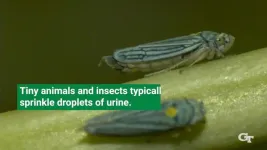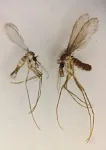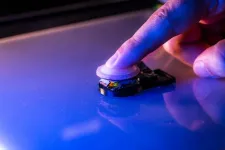(Press-News.org) Cicadas are the soundtrack of summer, but their pee is more special than their music. Rather than sprinkling droplets, they emit jets of urine from their small frames. For years, Georgia Tech researchers have wanted to understand the cicada’s unique urination.
Saad Bhamla, an assistant professor in the School of Chemical and Biochemical Engineering, and his research group hoped for an opportunity to study a cicada’s fluid excretion. However, while cicadas are easily heard, they hide in trees, making them hard to observe. As such, seeing a cicada pee is an event. Bhamla’s team had only watched the process on YouTube.
Then, while doing field work in Peru, the team got lucky: They saw numerous cicadas in a tree, peeing.
This moment of observation was enough to disprove two main insect pee paradigms. First, cicadas eat xylem sap, and most xylem feeders only pee in droplets because it uses less energy to excrete the sap. Cicadas, however, are such voracious eaters that individually flicking away each drop of pee would be too taxing and would not extract enough nutrients from the sap.
“The assumption was that if an insect transitions from droplet formation into a jet, it will require more energy because the insect would have to inject more speed,” said Elio Challita, a former Ph.D. student in Bhamla’s lab and current postdoctoral researcher at Harvard University.
Second, smaller animals are expected to pee in droplets because their orifice is too tiny to emit anything thicker. Because of cicadas’ larger size — with wingspans that can rival a small hummingbird’s — they use less energy to expel pee in jets.
“Previously, it was understood that if a small animal wants to eject jets of water, then this becomes a bit challenging, because the animal expends more energy to force the fluid’s exit at a higher speed. This is due to surface tension and viscous forces. But a larger animal can rely on gravity and inertial forces to pee,” Challita said.
The cicadas’ ability to jet water offered the researchers a new understanding of how fluid dynamics impacts these tiny insects —and even large mammals. The researchers published this challenge to the paradigm as a brief, “Unifying Fluidic Excretion Across Life from Cicadas to Elephants,” in Proceedings of the National Academy of Sciences the week of March 11.
For years, the research group has been studying fluid ejection across species, culminating in a recent arXiv preprint that characterizes this phenomenon from microscopic fungi to colossal whales. Their framework reveals diverse functions — such as excretion, venom spraying, prey hunting, spore dispersal, and plant guttation — highlighting potential applications in soft robotics, additive manufacturing, and drug delivery.
Cicadas are the smallest animal to create high-speed jets, so they can potentially inform applications in making jets in tiny robots/nozzles. And because their population reaches trillions, the ecosystem impact of their fluid ejection is substantial but unknown. Beyond bio-inspired engineering, Bhamla believes the critters could also inform bio-monitoring applications.
"Our research has mapped the excretory patterns of animals, spanning eight orders of scale from tiny cicadas to massive elephants,” he said. “We've identified the fundamental constraints and forces that dictate these processes, offering a new lens through which to understand the principles of excretion, a critical function of all living systems. This work not only deepens our comprehension of biological functions but also paves the way for unifying the underlying principles that govern life’s essential processes."
Citation: Elio J. Challita & M. Saad Bhamla. “Unifying Fluidic Excretion Across Life from Cicadas to Elephants,” Proceedings of National Academy of Sciences, March 2024.
END
Cicadas’ unique urination unlocks new understanding of fluid dynamics
While most small insects and mammals urinate in droplets, cicadas urinate in jets. Georgia Tech researchers say the finding could be used to create better robots and small nozzles
2024-03-11
ELSE PRESS RELEASES FROM THIS DATE:
New research sets trap for potentially deadly sandfly
2024-03-11
Scientists have discovered the specific enzyme that a species of sandfly uses to produce a pheromone attractant, which could lead to the creation of targeted traps to control them and reduce the spread of the potentially fatal disease, Leishmaniasis.
The team from the University of Nottingham’s School of Chemistry analysed the genome of the Lutzomyia longipalpis, a species of sandfly native to Brazil and South America that can spread a disease called Leishmaniasis.
The study identified the enzyme, called a Terpene Synthase that is responsible ...
A new sensor detects harmful “forever chemicals” in drinking water
2024-03-11
CAMBRIDGE, MA -- MIT chemists have designed a sensor that detects tiny quantities of perfluoroalkyl and polyfluoroalkyl substances (PFAS) — chemicals found in food packaging, nonstick cookware, and many other consumer products.
These compounds, also known as “forever chemicals” because they do not break down naturally, have been linked to a variety of harmful health effects, including cancer, reproductive problems, and disruption of the immune and endocrine systems.
Using the new sensor technology, the researchers showed that they could detect PFAS levels as low as 200 parts per trillion in a water sample. The device they designed could offer a way ...
Robotic interface masters a soft touch
2024-03-11
The perception of softness can be taken for granted, but it plays a crucial role in many actions and interactions – from judging the ripeness of an avocado to conducting a medical exam, or holding the hand of a loved one. But understanding and reproducing softness perception is challenging, because it involves so many sensory and cognitive processes.
Robotics researchers have tried to address this challenge with haptic devices, but previous attempts have not distinguished between two primary elements of softness perception: cutaneous cues (sensory feedback ...
Tuberculosis bacteria also present in 90% of those with symptoms, who are not diagnosed with TB
2024-03-11
Mycobacterium tuberculosis (Mtb), the bacteria that causes a tuberculosis infection, is present in exhaled breath of 90% of those presenting with suspected tuberculosis. This includes those who were negative on conventional sputum testing and not diagnosed with TB. This raises the possibility that those who have tested negative may be unknowingly transmitting the infection. Researchers from the University of Cape Town and Amsterdam UMC analysed results from over 100 patients who presented themselves to clinics in South Africa. These findings are published today in PNAS.
“If ...
U of M-led study reveals shared blueprint in brain development across different functional areas
2024-03-11
In a new study published in Proceedings of the National Academy of Sciences (PNAS), researchers from the University of Minnesota Medical School investigated brain development to understand how different areas of the brain become specialized in handling information such as vision, sound, touch and planning.
The study found that different areas of the brain start with a similar organization rather than already being specialized in early development. This suggests that the brain might use a single shared blueprint to guide early development.
“Throughout life, the brain continually builds on the foundations set ...
Researchers solve crucial cold-induced sweetening problem in potato production
2024-03-11
Researchers have discovered a game changer for the potato industry.
According to a new study published in a leading international society journal published by the American Society of Plant Biologists, a small genetic element is the cause of a major production problem in potatoes.
“Our manuscript reveals the mystery of “cold-induced sweetening” (CIS), the most troublesome and expensive problem for the potato processing industry,” explained Jiming Jiang, Corresponding Author of “Molecular dissection of an intronic enhancer governing cold-induced expression ...
Developed by VHIO, a novel AI-based and non-invasive diagnostic tool enables accurate brain tumor diagnosis, outperforming current classification methods
2024-03-11
Developed by VHIO, a novel AI-based and non-invasive diagnostic tool enables accurate brain tumor diagnosis, outperforming current classification methods
Developed by VHIO’s Radiomics Group in close collaboration with researchers of the Neuroradiology Unit at the Bellvitge University Hospital (HUB), DISCERN is a deep learning tool that leverages information of magnetic resonance imaging and facilitates brain tumor classification to aid clinical decision making.
Currently, a definitive diagnosis often requires neurosurgical interventions that compromise the quality of life of patients.
Trained to differentiate between the three most ...
Natural history specimens have never been so accessible
2024-03-11
With the help of 16 grants from the National Science Foundation, researchers have painstakingly taken computed topography (CT) scans of more than 13,000 individual specimens to create 3D images of more than half of all the world's animal groups, including mammals, fishes, amphibians and reptiles.
The research team, made of members from The University of Texas at Arlington and 25 other institutions, are now a quarter of the way through inputting nearly 30,000 media files to the open-source repository MorphoSource. This will allow researchers ...
NRL research physicists explore fiber optic computing using distributed feedback
2024-03-11
WASHINGTON – U.S. Naval Research Laboratory (NRL) researchers deliver novel contribution in fiber optics computing, Fiber Optic Computing Using Distributed Feedback paper recently published in Communications Physics journal, brings the Navy one step closer to faster, more efficient computing technologies.
Optical computing uses the properties of light, such as its speed and ability to carry large amounts of data, to process information more efficiently than traditional electronic computers.
In collaboration with Sandia National Laboratories and the University of Central Florida, NRL is aiming ...
Canals used to drain peatlands are underappreciated hotspots for carbon emissions
2024-03-11
A new study led by UC San Diego Scripps Institution of Oceanography postdoctoral scholar Jennifer Bowen finds that canals used to drain soggy peatlands in Southeast Asia are likely hotspots for greenhouse gas emissions.
The results, published March 8 in Nature Geoscience and supported by the Scripps Institutional Postdoctoral Program and Stanford University’s Precourt Institute for Energy, identify a previously unaccounted for source of emissions from these threatened, carbon-rich landscapes. Findings from the study suggest that the degradation of tropical peatlands in Southeast Asia has released even more planet-warming ...
LAST 30 PRESS RELEASES:
Numbers in our sights affect how we perceive space
SIMJ announces global collaborative book project in commemoration of its 75th anniversary
Air pollution exposure and birth weight
Obstructive sleep apnea risk and mental health conditions among older adults
How talking slows eye movements behind the wheel
The Ceramic Society of Japan’s Oxoate Ceramics Research Association launches new international book project
Heart-brain connection: international study reveals the role of the vagus nerve in keeping the heart young
Researchers identify Rb1 as a predictive biomarker for a new therapeutic strategy in some breast cancers
Survey reveals ethical gaps slowing AI adoption in pediatric surgery
Stimulant ADHD medications work differently than thought
AI overestimates how smart people are, according to HSE economists
HSE researchers create genome-wide map of quadruplexes
Scientists boost cell "powerhouses" to burn more calories
Automatic label checking: The missing step in making reliable medical AI
Low daily alcohol intake linked to 50% heightened mouth cancer risk in India
American Meteorological Society announces Rick Spinrad as 2026 President-Elect
Biomass-based carbon capture spotlighted in newly released global climate webinar recording
Illuminating invisible nano pollutants: advanced bioimaging tracks the full journey of emerging nanoscale contaminants in living systems
How does age affect recovery from spinal cord injury?
Novel AI tool offers prognosis for patients with head and neck cancer
Fathers’ microplastic exposure tied to their children’s metabolic problems
Research validates laboratory model for studying high-grade serous ovarian cancer
SIR 2026 delivers transformative breakthroughs in minimally invasive medicine to improve patient care
Stem Cell Reports most downloaded papers of 2025 highlight the breadth and impact of stem cell research
Oxford-led study estimates NHS spends around 3% of its primary and secondary care budget on the health impacts of heat and cold in England
A researcher’s long quest leads to a smart composite breakthrough
Urban wild bees act as “microbial sensors” of city health.
New study finds where you live affects recovery after a hip fracture
Forecasting the impact of fully automated vehicle adoption on US road traffic injuries
Alcohol-related hospitalizations from 2016 to 2022
[Press-News.org] Cicadas’ unique urination unlocks new understanding of fluid dynamicsWhile most small insects and mammals urinate in droplets, cicadas urinate in jets. Georgia Tech researchers say the finding could be used to create better robots and small nozzles







